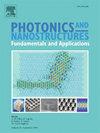Design and analysis of metamaterial-based ultra-broadband micro-scaled absorber with vanadium dioxide (VO2) and silicon dioxide (SiO2) for multiple terahertz applications
IF 2.5
3区 物理与天体物理
Q3 MATERIALS SCIENCE, MULTIDISCIPLINARY
Photonics and Nanostructures-Fundamentals and Applications
Pub Date : 2025-03-17
DOI:10.1016/j.photonics.2025.101381
引用次数: 0
Abstract
This research proposes an ultra-broadband terahertz absorber (UBTA) employing a metamaterial (MTM) structure based on vanadium dioxide (VO2). The top layer of the suggested MTM-UBTA model is made up of VO2 that is 0.2 µm thick, the bottom layer is made up of 3 µm thick gold material, and the middle layer is made up of silicon dioxide (SiO2) dielectric material of 7 µm thickness. The simulation results indicate an absorption bandwidth of 4.1 THz, from 2.8 to 6.9 THz, obtained under normal incidence. The suggested absorber maintains absorption above 92 % over a broad operating wavelength of 43.44 μm to 107.06 μm. The main goal of this study is to look into THz metamaterial absorbers based on VO2 in great detail, including every facet of their design validation and hys RevL through an ECM (Equivalent Circuit Model) approach. Furthermore, the impact of incident and polarization angle on absorbance for TE and TM modes is discussed and polarization insensitivity is verified. The prescribed MTM-ultra-broadband terahertz absorber is suitable for intelligent absorption, terahertz tuning, modulation, cloaking, optic-electro switching, biological sensing, and stealth technology.
多太赫兹应用超材料二氧化钒(VO2)和二氧化硅(SiO2)超宽带微尺度吸收器的设计与分析
本研究提出了一种采用基于二氧化钒(VO2)的超材料(MTM)结构的超宽带太赫兹吸收体(UBTA)。建议的MTM-UBTA模型的顶层由0.2 µm厚的VO2组成,底层由3 µm厚的金材料组成,中间层由7 µm厚的二氧化硅(SiO2)介电材料组成。仿真结果表明,在正常入射下,吸收带宽为4.1 太赫兹,范围为2.8 ~ 6.9 太赫兹。在43.44 μm至107.06 μm的宽工作波长范围内,该吸收剂的吸收率保持在92% %以上。本研究的主要目标是通过ECM(等效电路模型)方法详细研究基于VO2的太赫兹超材料吸收器,包括其设计验证和hys RevL的各个方面。此外,还讨论了入射角和偏振角对TE和TM模式吸光度的影响,并验证了偏振不敏感。规定的mtm超宽带太赫兹吸收器适用于智能吸收、太赫兹调谐、调制、隐身、光电开关、生物传感和隐身技术。
本文章由计算机程序翻译,如有差异,请以英文原文为准。
求助全文
约1分钟内获得全文
求助全文
来源期刊
CiteScore
5.00
自引率
3.70%
发文量
77
审稿时长
62 days
期刊介绍:
This journal establishes a dedicated channel for physicists, material scientists, chemists, engineers and computer scientists who are interested in photonics and nanostructures, and especially in research related to photonic crystals, photonic band gaps and metamaterials. The Journal sheds light on the latest developments in this growing field of science that will see the emergence of faster telecommunications and ultimately computers that use light instead of electrons to connect components.

 求助内容:
求助内容: 应助结果提醒方式:
应助结果提醒方式:


